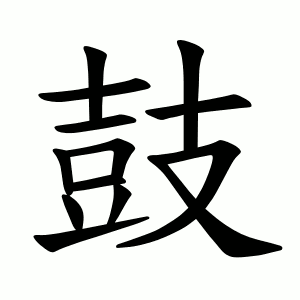鼓
- drum;
Etymology
It is a compound ideogram formed from:
支 (ji, “to support” or “branch”) – representing drumsticks, and
壴 (ju, an ancient musical instrument) – representing the drum itself.
Together, the character depicts striking a drum with sticks, which came to represent the drum itself.
In ancient Chinese cities, drums and bells were used to mark the time of day.
During the Ming and Qing dynasties, this system was known as 晨鐘暮鼓 (morning bell, evening drum).
The bell was rung in the east bell tower at dawn.
The drum was struck in the west drum tower at dusk, to announce morning and evening hours.
Usage in Korean
When used as a radical, 鼓 conveys meanings related to drums, sound, or beating/pounding.
Examples of characters using this radical:
鼛 (큰북 고, large drum)
鼕 (북소리 동, the sound of a drum)
鼙 (비고 비, small war drum)
- 土廿十水 (GTJE)
- ⿰ 壴 支
